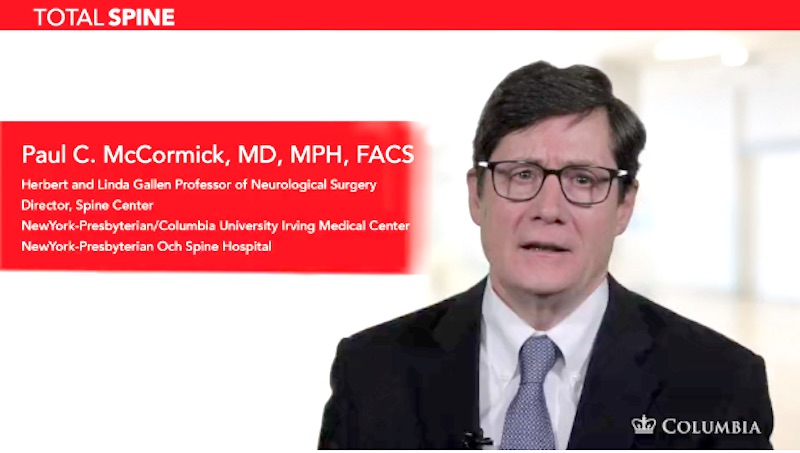| Header | Text |
| What is a MIS Transforaminal Interbody Lumbar Fusion (TLIF)? | Transforaminal = through the foramina, openings through which nerve roots exit the spine
Interbody = between the vertebral bodies
Lumbar = having to do with the spine in the lower back
Fusion = a process in which bones “fuse,” or grow together into one bone
A Transforaminal Interbody Lumbar Fusion treats spinal instability or weakness by permanently uniting bones of the lumbar (lower) spine. The goals of a TLIF are to decompress (remove the pressure from) the spinal cord and/or nerves, re-stabilize the spine, and prevent further movement and degeneration at the joints in question.
A Transforaminal Interbody Lumbar Fusion is a particular type of fusion, or surgical procedure that permanently fuses, or unites, bones of the spine. The fusion is achieved using bone graft: bone material either acquired from a bone bank or transplanted from elsewhere in the patient’s own body. Over time, the bone graft and the bones of the spine grow together, forming one united bone.
Though a TLIF is performed through an incision at the back of the spine, the techniques used during the surgery enable the surgeon to access and fuse bones at the front of the spine as well. The bones at the front of the spine are called the vertebral bodies. Fusion between the bodies gives the procedure the “interbody fusion” portion of its name.
To allow the surgeon to access the front of the spine, bone and disc material are removed during a TLIF. The openings called foramina, through which the nerve roots exit the spine, are enlarged. (Part of the surgery takes place through the enlarged foramina–hence the “transforaminal” portion of the procedure name.) This removal of bone and disc and enlargement of the foramina makes the TLIF more than just a fusion surgery. It’s also a decompression surgery–a surgery that can relieve pressure on the spinal cord or nerve roots.
A TLIF may be performed using one of several surgical “exposures,” or methods of reaching the target area:
- a standard, “open” surgical exposure that reveals the area to the surgeon’s eye
- a smaller “mini-open” exposure that uses some minimally invasive techniques
- a minimally invasive exposure that uses only very small incisions and minimizes disruption to the body’s tissues, often resulting in less postoperative pain and a shorter recovery
No matter the type of exposure, though, the indications and goals of TLIF procedures are the same.
|
| When is this Procedure Performed? | TLIF can be performed for numerous spinal conditions, especially degenerative disc disease, herniated discs, or spondylolisthesis. These conditions may cause spinal cord or nerve root compression, spinal instability, and weakness. The TLIF procedure is performed to decompress (remove the pressure from) the spinal cord and/or nerves, re-stabilize the spine, and prevent further movement and degeneration at the joints in question.
|
| How is this Procedure Performed? | A TLIF is performed under general anesthesia, which means the patient is unconscious.
The surgeon makes an incision in the lower back over the bones of the spine. If material for a bone graft is to be retrieved from the patient’s own hip, this incision can also be used to retrieve the bone.
The surgeon removes a portion of bone and joint at the back and side of the vertebra. These sections of bone and joint are called, respectively, the lamina and the facet joint. The facet joint helps form the borders of the foramina, and the surgeon identifies and protects the nerves traveling through the foramina above and below the removed facet joint. This bony removal helps relieve the pressure on the spinal cord and/or nerves, and it also allows the surgeon space to access the disc between the vertebral bodies at the front of the spine.
The surgeon then uses specialized instruments to remove a portion of the intervertebral disc between the vertebral bodies. The surgeon places a spacer (a supportive device) between the vertebral bodies, where the disc once was. The spacer holds the vertebrae the proper distance apart, just as the disc once did.
The most common type of spacer is called an interbody cage. It is a small metal implant packed with bone graft. The cage is porous, like a grate or a kitchen strainer, so that bone graft may grow through it and fuse with the adjacent vertebral bodies. The surgeon may also fill the area around the spacer with morselized (fragmented) bone, which helps promote fusion between vertebral bodies. A concentrated form of Bone Morphogenic Protein (BMP) may also be used in the area where fusion is desired. BMP is a substance produced naturally by the body to promote bone growth, and it helps encourage fusion.
Finally, the surgeon will usually fuse the bones at the back of the spine as well. Using instruments such as screws and rods, the surgeon connects adjacent vertebrae, preventing movement at the joint between them. Then bone graft is placed in the area to fuse the vertebrae together.
Instruments such as the cage, screws, and rods are intended to provide short-term stability to the spinal column. Good bony fusion provides long-term stability.
|
| How Should I Prepare for this Procedure? | Since smoking affects how the bones will fuse after the procedure, it is recommended that patients stop smoking prior to a TLIF. If you currently smoke, speak to your neurosurgeon about quitting.
Make sure to tell your doctor about any medications or supplements that you’re taking, especially medications that can thin your blood such as aspirin. Your doctor may recommend you stop taking these medications before your procedure. To make it easier, write all of your medications down before the day of surgery. Be sure to tell your doctor if you have an allergy to any medications, food, or latex (some surgical gloves are made of latex).
On the day of surgery, remove any nail polish or acrylic nails, do not wear makeup and remove all jewelry. If staying overnight, bring items that may be needed, such as a toothbrush, toothpaste, and dentures. You will be given an ID bracelet. It will include your name, birthdate, and surgeon’s name.
|
| What Should I Expect After the Procedure? | How long will I stay in the hospital?
On average, patients are discharged three to five days after the surgical procedure.
Will I need to take any special medications?
Patients may be prescribed pain medications to help manage pain.
Will I need to wear a brace?
In some cases, the surgeon may recommend using a spinal brace to help support the back while it heals.
When can I resume exercise?
It is recommended that patients limit their activities for the first several weeks following the operation. Patients are usually encouraged to increase their activities as they are able to tolerate.
Will I need rehabilitation or physical therapy?
Patients typically begin physical therapy the day after surgery.
When will I return for follow-up with my surgeon?
The surgeon typically schedules a follow-up visit for several weeks after surgery.
Will I have any long-term limitations due to a TLIF?
The fusion portion of the TLIF is intended to prevent movement at a joint in the spine. Therefore, you will probably feel stiffness at the level of the TLIF. A fusion of two vertebrae will produce a smaller amount of stiffness; a longer fusion will produce a correspondingly longer section of stiffness.
|
| Preparing for Your Appointment | At the Spine Hospital at the Neurological Institute, our spinal neurosurgeons are experienced in the evaluation and performance of all types of spinal fusion.
Drs. Paul C. McCormick, Michael G. Kaiser, Peter D. Angevine, Alfred T. Ogden, Christopher E. Mandigo, Patrick C. Reid and Richard C. E. Anderson (Pediatric) are experts in Transforaminal Lumbar Interbody Fusion (TLIF).
|


